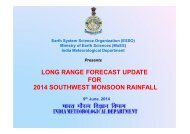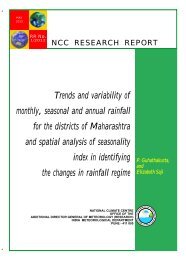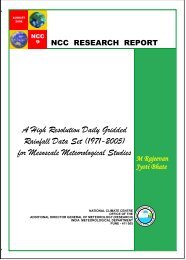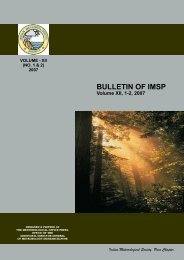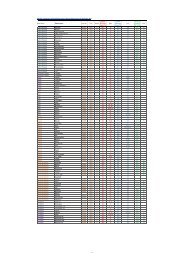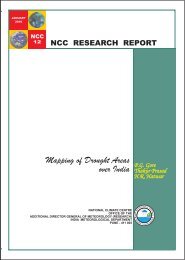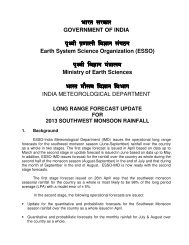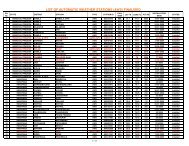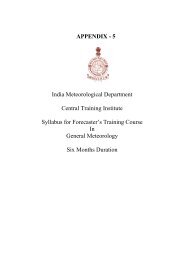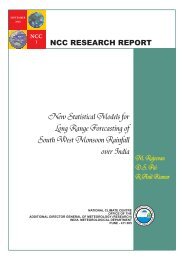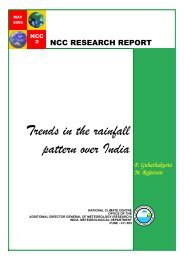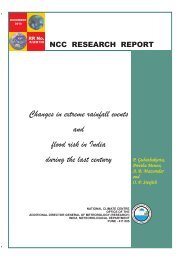Trends in Precipitation Extremes over India - (IMD), Pune
Trends in Precipitation Extremes over India - (IMD), Pune
Trends in Precipitation Extremes over India - (IMD), Pune
You also want an ePaper? Increase the reach of your titles
YUMPU automatically turns print PDFs into web optimized ePapers that Google loves.
From the list prescribed by WMO, we have not considered <strong>in</strong>dices of R10mmand R20mm, because ra<strong>in</strong>fall events of 10 or 20 mm are quite common <strong>in</strong> the <strong>India</strong>nsub-cont<strong>in</strong>ent dur<strong>in</strong>g the southwest monsoon season. Hence, we have consideredR7.5cm (75 mm) and R12.5cm (125mm) to study the trends <strong>in</strong> heavy precipitationfrequencies of ra<strong>in</strong>fall greater than or equal to 7.5cm and 12.5cm.The def<strong>in</strong>itions of <strong>in</strong>dices allow seasonal and monthly partitions. As mentionedearlier, here, we have considered only the southwest monsoon season (June –September), the ma<strong>in</strong> ra<strong>in</strong>y season <strong>in</strong> <strong>India</strong>. Most of the <strong>in</strong>dices are def<strong>in</strong>ed <strong>in</strong> termsof counts of days cross<strong>in</strong>g the thresholds either absolute (fixed) thresholds orpercentile (variable) thresholds. Annual or seasonal day-count <strong>in</strong>dices based onpercentile thresholds are expressions of anomalies relative to the local climate.Consequently, the value of the thresholds is site specific. Such <strong>in</strong>dices allow forspatial comparisons, because they sample same part of precipitation (probabilitydensity) distributions at each station. On the other hand, annual/seasonal day-count<strong>in</strong>dices based on absolute thresholds are less suitable for spatial comparisons. Thereason be<strong>in</strong>g, <strong>over</strong> an area as large as <strong>India</strong>, thresholds of sample may vary differentfor different parts of the precipitation distributions. This means that <strong>in</strong> another climateregime the variability <strong>in</strong> such <strong>in</strong>dices readily stems from another season. Forexample, R7.5cm may be an extreme event <strong>in</strong> North-west <strong>India</strong>, while such eventsare quite common along the west coast and NE <strong>India</strong>.Extreme ra<strong>in</strong>fall <strong>in</strong>dices considered for the analysis are calculated for eachyear for each station. <strong>Trends</strong> of these <strong>in</strong>dices are calculated us<strong>in</strong>g l<strong>in</strong>ear regressionmodel to calculate the magnitude of the trends. S<strong>in</strong>ce most of the <strong>in</strong>dices are countsof days, a non-parametric model will be the best suited to test the significance ratherthan us<strong>in</strong>g Students’ t test. Hence, we have used the Kendall -Tau test (Press et al.,1986) to exam<strong>in</strong>e the significance of the trend. The trends referred to as significantexceed the 95% or 99% confidence limits <strong>in</strong> the Kendall–Tau test. As mentionedearlier, miss<strong>in</strong>g data was not filled up while calculat<strong>in</strong>g the <strong>in</strong>dices and trends.6



